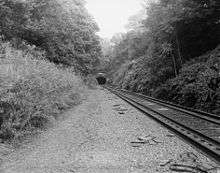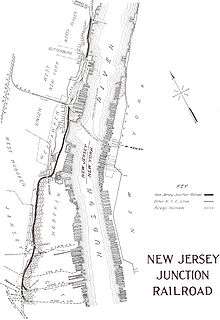Weehawken Terminal
Weehawken Terminal | |
|---|---|
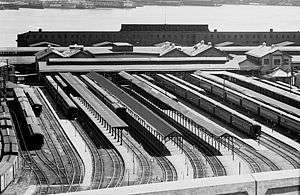 Weehawken Terminal and yard, circa 1955 | |
| Coordinates | 40°46′18″N 74°00′46″W / 40.771639°N 74.012750°WCoordinates: 40°46′18″N 74°00′46″W / 40.771639°N 74.012750°W |
| Operated by | New York Central Railroad (NYC) |
| Line(s) | West Shore Railroad |
| Tracks | 16 |
| Train operators | NYC, NYO&W |
| Connections |
|
| History | |
| Opened | 1884 |
| Closed | 1959 |
| Location | |
 Weehawken Terminal Location on a map showing the railroads in the New York City area ca 1900 | |
Weehawken Terminal was the waterfront intermodal terminal on the North River (Hudson River) in Weehawken, New Jersey for the New York Central Railroad's West Shore Railroad division. It opened in 1884 and closed in 1959.[1] The complex contained five ferry slips, sixteen passenger train tracks, car float facilities, and extensive yards. The facility was also used by the New York, Ontario and Western Railway. The terminal was one of five passenger railroad terminals that lined the Hudson Waterfront during the 19th and 20th centuries, with others located at Hoboken, Pavonia, Exchange Place and Communipaw.
Weehawken Ferry
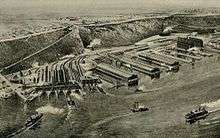
A patent for a ferry route from Weehawken to Manhattan was first granted by Governor of New York Richard Coote in 1700. It was a sail and row service later superseded by steamboat service, notably at Hoboken in 1834.[2] The route then operated sporadically for years, and became object of a legislative investigation in 1870.[3] It was purchased by the New Jersey Midland Railway in 1871. From 1913 until the 1927 opening of the Holland Tunnel, it was a component of the Lincoln Highway, the first transcontinental highway in the United States, which began at Times Square, crossed the river, and travelled up Hudson Palisades along Pershing Road. In addition to 42nd Street, boats also travelled to Cortland Street. The Weehawken was the last ferry to the West Shore Terminal on March 25, 1959 at 1:10 am, ending 259 years of continuous ferry service.[4]
Railroad lines
The West Shore Railroad maintained extensive routes to the north and west.[5] The New York Central bought the New York, West Shore and Buffalo Railway on November 24, 1885 and reorganized their new acquisition as the West Shore Railroad on December 5, immediately leasing it for 475 years from January 1, 1886. Trains departed the terminal and travelled under Bergen Hill, as the southern portion of the Hudson Palisades is known, in a tunnel that had been built in the three preceding years.[6] They travelled inland and north along the Palisade ridge between the competing Erie Railroad Northern Branch and Pascack Valley Line. At Haverstraw the route returned to the river proceeding north to Kingston and Albany and eventually to Buffalo. Suburban service to the Northern Valley in Bergen County and Rockland County included stops at Bogota, Dumont, Tappan, and Nyack. In the early 1990s there were studies made to consider the revival of service along the right-of-way to Nyack.[7][8] The NYO&W mainline ran to Oswego, a port city on Lake Ontario. It had branch lines to Scranton, Pennsylvania and to Kingston; Port Jervis; Dehli; Utica and Rome in New York. Using the same tunnel, the New York Central also operated the New Jersey Junction Railroad south to Jersey City and the New Jersey Shore Line Railroad north to Edgewater. Portions of those rights-of-way became part of Conrail's River Line and subsequently the Hudson–Bergen Light Rail.
Streetcars
Between 1892-1949 streetcars, initially operated by the North Hudson County Railway, and later the Public Service Railway as lines 19 Union City, 21 West New York, 23 Palisade, 25 Weehawken, ran along Pershing Road providing local access to the terminal. For a brief period in the 1890s the terminal was also served by a massive elevator structure which transported passengers to a trestle where they could board streetcars to the Eldorado, a pleasure garden which overlooked it, and Nungesser´s Guttenberg Racetrack.[9][10] Just over the road from the former site of the station is now Port Imperial HBLR Station.
Site
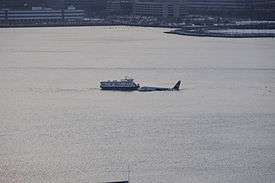
The Weehawken waterfront is located north of Weehawken Cove on a long narrow strip of land between the Hudson River and Hudson Palisades that in the last centuries has been transformed from an estuary flood zone once called Slough's Meadow[11] to an extensive rail and shipping port and, since the 1990s to a residential and recreation area. Many duels, including the famous 1804 the Burr–Hamilton duel took place on a site latter obliterated by rail infrastructure. The Erie Railroad (which maintained extensive yards, docks, and barges)[12] Pier D and Piershed is a remnant of the rail era that is New Jersey Register of Historic Places site designated in 1984.[13] renovated and used as office space. The United Fruit Company once maintained the largest banana warehouse in the USA nearby.[14] The Hudson River Waterfront Walkway is a partially completed promenade along the bulkhead. On a much smaller scale restoration of rail and ferry services began in 2006 at Weehawken Port Imperial provided by Hudson Bergen Light Rail[15] and New York Waterway.[16] which opened its new passenger ferry terminal[17][18] Ferries travel to Pier 79, Battery Park City Ferry Terminal. and Pier 11/Wall Street.[19] In 2009, the terminal was instrumental in the rescue of passengers for US Airways Flight 1549, which made an emergency landing on the Hudson River.[20]
See also
- Bergen Hill
- Bergenline Avenue (HBLR station)
- Timeline of Jersey City area railroads
- List of ferries across the Hudson River in New York City
- Railroad terminals in New York City
- List of Public Service Railway lines
- New York Central Railroad 69th Street Transfer Bridge
- New York Central Tugboat 13
References
- ↑ Sherman, Lauren; Gaulkin, Ellen Robb (February 2009). Weehawken. (Images of America). Arcadia Publishing. ISBN 978-0-7385-6268-1.
- ↑ Baxter, Raymond J.; Adams, Arthur G. (1999). Railroad Ferries of the Hudson. New York: Fordham University Press. p. 124. ISBN 0-8232-1954-2.
- ↑ "The Weehawken Ferry". The New York Times. March 20, 1870. p. 6. Retrieved 2010-05-30.
- ↑ Adams, Arthur G. (1996). The Hudson Through the Years. New York: Fordham University Press. ISBN 978-0-8232-1676-5.
- ↑ "Advertisement for the West Shore Railway - 1883". The Weehawken Time Machine. Retrieved 2011-03-03.
- ↑ Berliner, Harvey L.; Campo, David W.; Dickerson, Charles N.; Mack, Glenn (November 2003), "Design and Construction of the Weehawken Tunnel and Bergenline Avenue Station for the Hudson–Bergen Light Rail Transit System" (PDF), Transportation Research E-Circular, Transportation Research Board, E-C058: 389–406, ISSN 0097-8515, retrieved 2011-07-30
- ↑ Gilbert, Pat R. (October 27, 1994). "West Shore Line Nearing Fast Track". The Record. Bergen County. Retrieved 2011-07-30.
- ↑ "MIS/DEIS for the West Shore Corridor". United States Environmental Protection Agency. Federal Transit Administration. June 18, 2001. Retrieved 2011-07-30.
- ↑ Collosus of Weehawekn
- ↑ North Hudson Railway
- ↑ New York Historical Society (1995). Jackson, Kenneth T., ed. The Encyclopedia of New York City. New Haven: Yale University Press. pp. 398–400. ISBN 0-300-05536-6.
- ↑ Erie Railroad Weehawken facilities
- ↑ New Jersey Register of Historic Places in Hudson County per July 2009
- ↑ Martin, Antoinette (June 26, 2005). "'Repositioning' a Riverfront Town". The New York Times. Retrieved 2010-05-30.
- ↑ Weehawken Tunnel Photos (The Subway Nut.com).
- ↑ Waterway routes and schedule.
- ↑ NY Waterway Weehawken Terminal.
- ↑ Weehawken Ferry Terminal description and photo
- ↑ NYC.gov website
- ↑ Applebome, Peter (January 17, 2009). "A Small Town's Recurring Role as a Rescue Beacon". The New York Times. Retrieved 2010-05-30.
External links
- Weehawken ferry company (1853). Charters of the Weehawken ferry company [scan]
 . F. Hart.
. F. Hart. - Historic American Engineering Record (HAER) No. NJ-109-A, "New York, West Shore & Buffalo Railroad, Weehawken Tunnel"
- Old Photo of Terminal
- Street Terminal photo
- 1882 description of site
| Former services | ||||
| Preceding station | New York Central Railroad | Following station | ||
|---|---|---|---|---|
| Terminus | West Shore Route | Ridgefield Park toward Albany |
||
